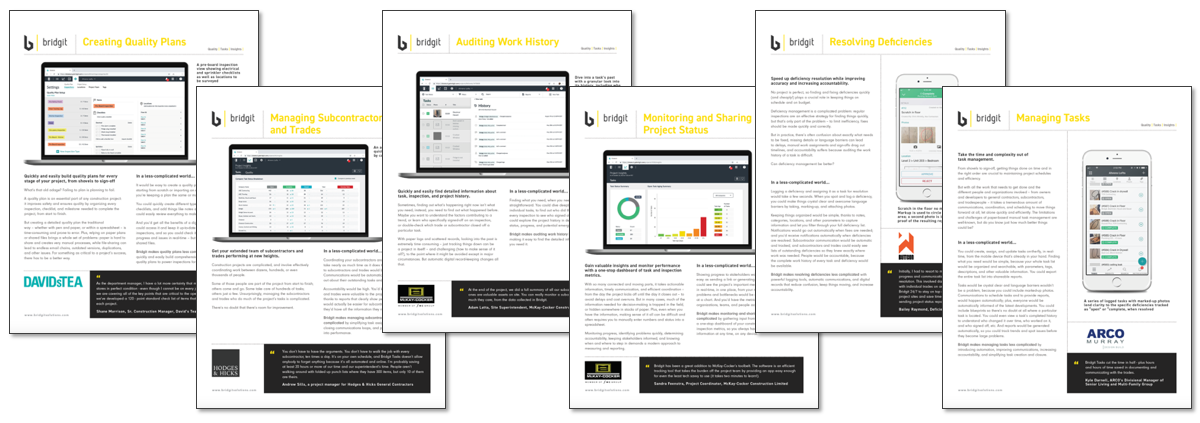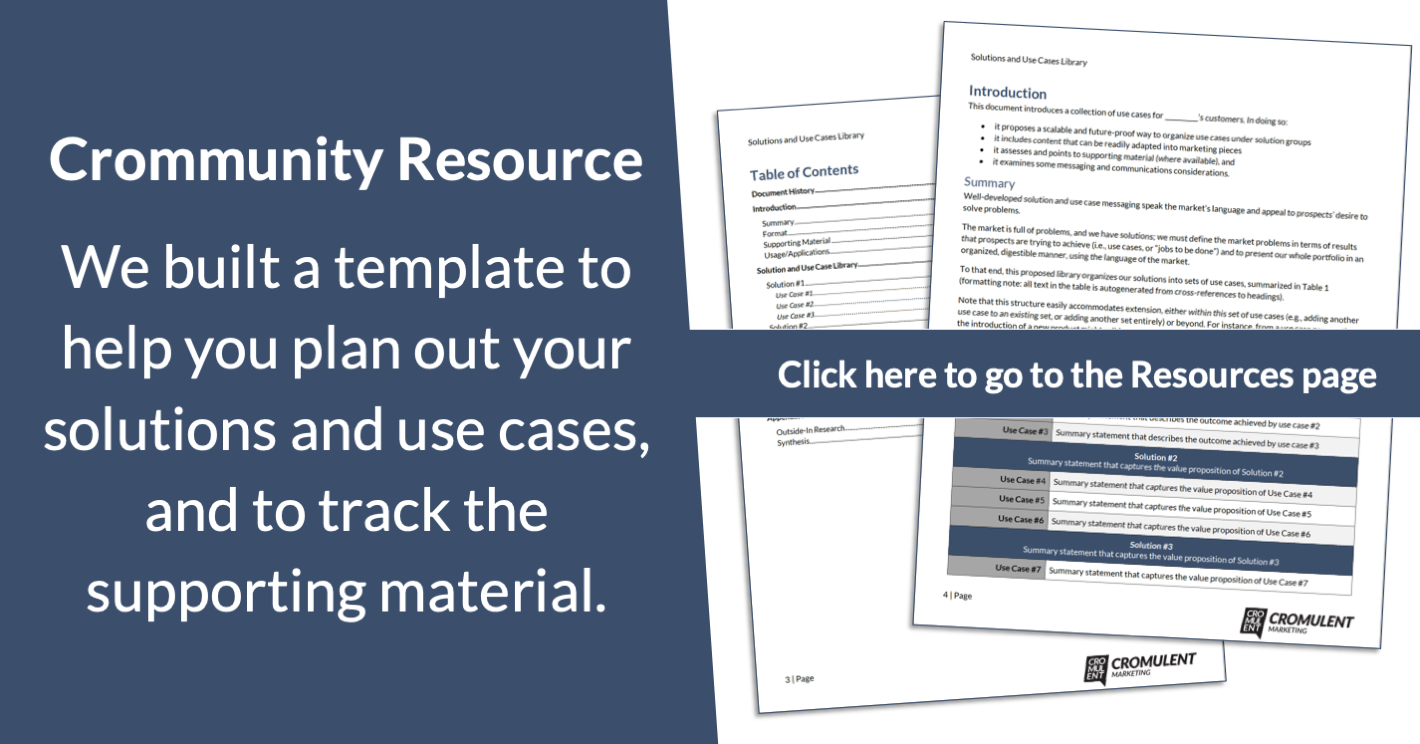Bridging a Gap
“Inside-out thinking is the biggest barrier to success. Outside-in thinking is the best aid.” – Al Ries & Jack Trout, in Positioning
Well-developed solution and use case messaging speak the market’s language and appeal to prospects’ desire to solve problems. In this post, I walk through a real-world example of how we developed a full solution and use case library for a client—Bridgit—from scratch, in a few days.
Background
The need for use case and solution material was identified in our earliest conversations. For example, in our first conversation with the Chief Revenue Officer, he specifically mentioned that prospects saw the company’s solution as being useful only for particular applications, and that providing a longer list of use cases might help to overcome this perception: “We talk about value at high level, but we don’t home in on use cases. So trying to educate prospects that although we’re a simplified field solution, but can do a bunch of use cases…”
A few weeks after addressing immediate, long-standing gaps by producing a Messaging Guide and developing a product brochure, we turned our attention to building a solution and use case library.
The Project
We knew that the output of the project would be a solution and use case hierarchy; that is, one or more solution areas, each of which included one or more use cases.
This type of top-of-funnel content clearly shows your value proposition, because solutions and associated use cases explain the market problems you solve (or the jobs you can do), in the same language used by customers and prospects. This material serves as a communication bridge between, on the one side, what the product can do and, on the other side, the problems that prospects were looking to solve.
In this situation, we were basically starting from scratch, as nothing had really been documented in the past.
Bridgit’s software app, Closeout, was named after the primary use case for which it was designed; since its debut, new capabilities had been introduced, but the market perception had stuck—a use case library would go a long way to showcasing the breadth of problems that Bridgit’s evolving solution could address.
Research
Both the NPS responses and customer interviews also provided useful guidance on the real-world language customers use; adopting this language increases the appeal and authenticity of our use cases.
We began by conducting research.
From writing the Messaging Guide and product brochure, we already had a well-developed understanding of the product’s capabilities; however, we needed to learn more about the market problems that prospects were looking to solve.
For this project, especially, it was absolutely critical that we take an outside-in perspective. Unfortunately, given our aggressive timeframe, we didn’t have the opportunity to speak directly with a long list of customers and prospects; but that didn’t mean we didn’t have options.
- We began by reviewing the transcripts and notes from our earlier conversations with the Co-Founders and CRO, specifically looking for anything that shone a light on the customer perspective.
- Next, we spoke with team members who occupied customer-facing roles, including a Senior Product Manager and the Customer Success Director. These conversations gave us a good foundation and alerted us to some important resources, including Net Promoter Score (NPS) surveys.
- We examined the NPS responses from the two most recent NPS surveys. These responses provided an unfiltered view into what customers think, including areas of satisfaction or dissatisfaction, and occasional references to how customers are actually using the products.
- Similarly, we reviewed all transcripts of customer interviews to gain additional insights; while fewer in quantity than the NPS responses, the interviews provided much deeper insights into the problems that customers face in the real world and the ways in which they use the company’s products to address those problems. Both the NPS responses and customer interviews also provided useful guidance on the real-world language Bridgit’s customers used; by adopting this language, we could increase the appeal and authenticity of the use cases.
- Next, and with the potential use cases starting to crystallize, a detailed review of existing blog content helped to refine the understanding of and division between use cases and provided more complete profiles of customers and customer experiences.
- While searching the blog archives, we became aware of a well-hidden-but-extremely-useful customer support knowledge base of articles, tips, demo animations, and so on. We reviewed and documented everything.
- We then explored third-party sites and industry publications to broaden our outside-in view of the market, including trends, priorities, and language.
- After the written web content was reviewed, next up was video: at the time, they had 26 videos totalling slightly less than one hour of video content.
Synthesis
One challenge in exercises like this one is to know how and where to draw the line between related use cases; when in doubt, we always apply the prospect’s perspective.
Taking everything that we’d learned, we identified a dozen specific problems that the product could potentially address, and we grouped them into three solution areas.
One challenge in exercises like this one is to know how and where to draw the line between related use cases; when in doubt, we always apply the prospect’s perspective. If the prospect sees two separate problems, then we’ve got two separate use cases, even if they’re abundantly alike.
Similarly, it isn’t always clear how to define the larger solution areas; again, the best practice here is to take the prospect’s perspective.
Our Proposal
We delivered our proposal in the form of a “Use Case Library” document. This 22-page guide included:
- A summary of the overall proposal
- Content for the three solution areas we proposed
- Content for the 12 use cases we proposed
- All our recommended material that could be used to support and strengthen the 12 use cases
- A brief discussion about how to leverage the use cases in communications
- An explanation of our methodology, so internal people could continue the efforts in the future
Each specific use case consisted of:
- A carefully chosen title that used clear, real-world customer language
- A summary statement of the intended experiential outcome of the use case (i.e., describes what the customer is trying to achieve)
- Contextual information, including introductory and background content to establish credibility and define the use case, usually by describing the reason why this use case is important and challenges with existing alternative approaches
- Idealized solution, using aspirational statements of what a great solution would look like
- A brief closing statement that explicitly captured our client’s ability to solve the problem
Because we’d reviewed literally every piece of existing content, we accompanied each use case with a table that assessed the state of supporting material and included links to suitable content that already existed. In the minds of prospects, this type of supporting information takes a use case from the world of the theoretical into the world of the real, increasing credibility and significantly lessening perceived risk.
Because we’d reviewed literally every piece of existing content, we accompanied each use case with a table that assessed the state of supporting material and included links to suitable content that already existed. More specifically, each of the 12 use cases was accompanied by a table linking to any and all:
- Screenshots that showed still images of the company’s products, features, and capabilities being used to contribute to achieving the use case
- Videos that illustrated—ideally from start to finish, and in no more than two minutes—using the products to achieve a use case (note that this approach is different from simply showing off features and relating them to use cases; instead, the use case is the focal point, and the products play a supporting role)
- Customer quotes that show real-world customer validation that Bridgit has a valid solution to the customer problem captured by the use case
- Project Spotlights and Success Stories that, respectively, briefly highlight a project where this use case was achieved (i.e., through a combination of project details, a customer quote, and brief wrapper content) or explain at slightly longer length a real-world success
In the minds of prospects, supporting information takes a use case from the world of the theoretical into the world of the real, increasing credibility and significantly lessening perceived risk
In the minds of prospects, this type of supporting information takes a use case from the world of the theoretical into the world of the real, increasing credibility and significantly lessening perceived risk.
By taking a higher-level view, we were able to assess the overall state of supporting material, including identifying important gaps. We summarized this information in a table; going forward, this table could easily serve as a to-do list for focused, purposeful content.
In this case, the summary table showed that Bridgit was in a pretty strong position when it came to having customer quotes that supported the value propositions our use cases described. Over the years, they’d secured many customer testimonials, so there were plenty of quotes from which to choose; unfortunately, collecting these quotes hadn’t followed any strategy, so they didn’t map to particular needs (in this case, to use cases—which obviously hadn’t yet been defined). By coincidence, some were great and others were good. In fact, for some use cases we had a half dozen quotes from which to choose! However, for some, we had to rely on relatively poor quotes and, for a few, we couldn’t find any suitable quotes at all.
We recommend creating a prioritized list of things you want customers to say, to cover both the breadth and depth of your solutions, and then – wherever possible – guide them in that direction. Over time, following this approach arms you with real-world customer validation for basically everything you say.
We see this happen at a lot of tech companies: they’re so happy to get customer quotes that they let them come in at random. Instead, we recommend creating a prioritized list of things you want customers to say, to cover both the breadth and depth of your solutions, and then—wherever possible—guide them in that direction. Over time, following this approach arms you with real-world customer validation for basically everything you say.
Similarly, between the YouTube channel and the customer support site (I can’t stress enough how useful this site is—it’s really a hidden gem!), there were several dozen videos and animations. But most of these videos showed how to use particular features, in general, rather than relating the features to specific problems and use cases.
Review and Fine-Tuning
The Director of Marketing circulated the proposed use cases internally for review.
Specifically:
- We wanted to make sure that there wasn’t any unintended overhang; one use case, in particular, stood out as being potentially a little too ambitious, and no one wanted to mislead prospects (ultimately, we marked it for future consideration, and omitted it from the current library)
- We wanted to make sure we’d accurately captured the products’ abilities to solve these real-world problems, so we needed people with more product expertise to review for accuracy
After a quick review cycle, we made the necessary tweaks and the proposal was complete.
One interesting piece of feedback that came out of the internal review was a couple of people wondering why the use case proposal didn’t cleanly map to the way the product is licensed.
Your product and license structure isn’t your story. Nothing could be more inside-out. Instead, take the outside-in approach of listening to your customers about what problems they want to solve, and then guide them to the things you sell that solve those problems.
It’s a fair and common question, and it’s worth addressing because it’s something with which almost every tech company grapples at some point in time.
Here’s how I’ve answered it for the past few years: “Your product and license structure isn’t your story.”
I learned this lesson the hard way, over the course of several years, when I inherited a product story that was based entirely on internal licensing and pricing decisions—nothing could be more inside-out than going, “Here’s how we’ve decided to sell what we’ve built. This piece sort’ve helps you with this problem. That piece sort’ve helps you with that problem. You need both of these to address that other problem…”
I implore all tech companies to avoid this mistake entirely, or to break out of this habit immediately!
Instead, take the outside-in approach of listening to your customers about what problems they want to solve, and then guide them to the things you sell that solve those problems.
Output and Aftermath
Only two days after we delivered the revised use case library, Bridgit’s internal designer had turned each of the 11 final use cases into a one-page PDF perfect for sharing with prospects and promoting via digital channels. Because we’d written out all the content and specified where to find supporting material, producing the final pieces was a breeze!
Only two days after we delivered the revised use case library, Bridgit’s internal designer had turned each of the 11 final use cases into a one-page PDF perfect for sharing with prospects and promoting via digital channels. Because we’d written out all the content and specified where to find supporting material, producing the final pieces was a breeze!

Additionally, the use cases were added to the website and—over the ensuing weeks—each was promoted over social media channels and referenced in blog posts and articles. There’s no doubt that prospects who sees this material won’t make the mistake of thinking Bridgit’s products are limited to only one or two applications.
To Infinity, and Beyond!
Obviously, the one-pagers could easily be bundled together with the solution material into a full solution brochure, and even combined with the product information (and perhaps augmented by article content) to produce a more complete resource.
Moreover, by following the ‘to-do list’ we provided in our proposal, Bridgit could quickly create a comprehensive library of video content that appeals to prospects’ interests and motivations: finding proven solutions to real-world problems.
The possibilities are substantial, both because the content is so easily adaptable and because it was created by following a truly outside-in approach that will stand the test of time.



